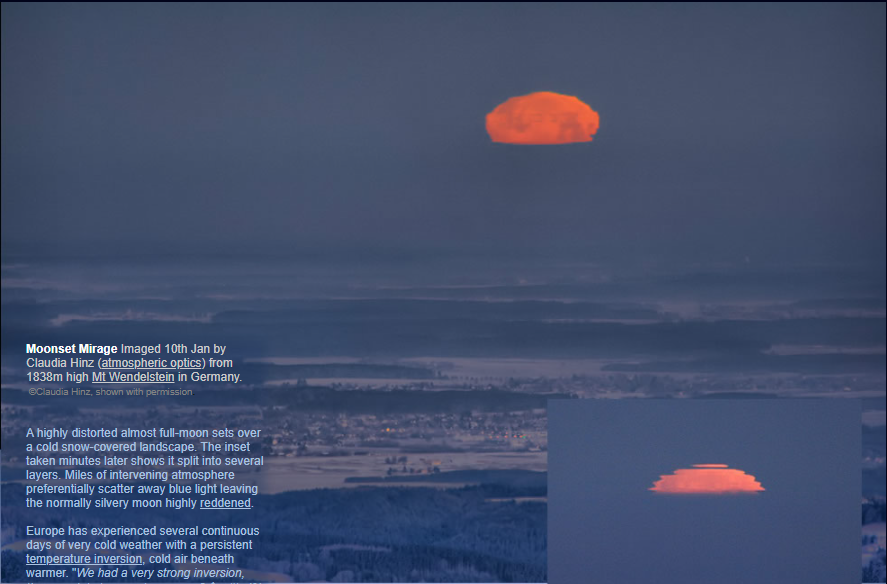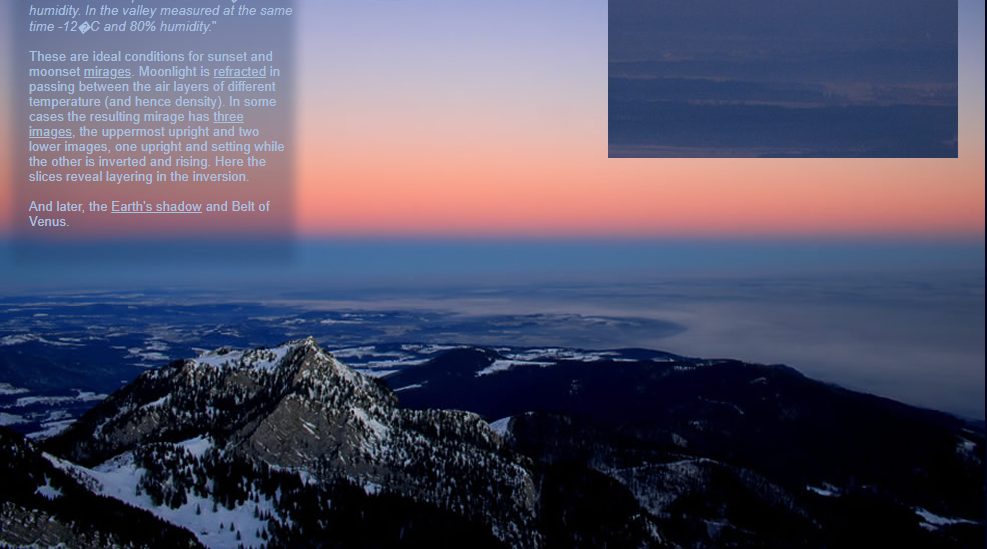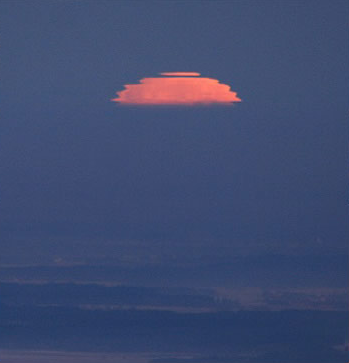Moonset Mirage
Moonset Mirage: A Spectacular Optical Phenomenon
Have you ever witnessed a moonset mirage? It is a mesmerizing atmospheric optics phenomenon that occurs when a highly distorted full moon appears to set over a cold, snow-covered landscape. This stunning display of nature's beauty can be observed under specific weather conditions, making it a rare and captivating sight.
The Splendor of Moonset Mirage
Imagine gazing at the moon as it descends towards the horizon, only to witness it split into several layers. This optical illusion is caused by the interaction of moonlight with the layers of air at different temperatures and densities. As the moon's light passes through these varying air layers, it becomes refracted, resulting in the mirage effect.
Ideal Weather Conditions
Moonset mirages are more likely to occur during periods of very cold weather with a persistent temperature inversion. A temperature inversion happens when cold air becomes trapped beneath a layer of warmer air. These conditions create an ideal environment for the formation of mirages.
To illustrate this, let's take an example from Europe where such a phenomenon was captured on camera. In Germany's Mt Wendelstein, situated at an elevation of 1838 meters, a strong inversion was observed. The temperature on the mountain was recorded at +2°C with only 4% humidity, while in the valley, measured at the same time, it was -12°C with 80% humidity. Such stark temperature differences and the presence of an inversion contribute to the occurrence of moonset mirages.
Unveiling the Layers
One intriguing aspect of moonset mirages is that they often reveal the layering within the inversion. The slices captured in the photographs showcase distinct layers of air at different temperatures and densities. This layering effect adds depth and complexity to the mirage, enhancing its visual appeal.
Threefold Mirages
In some instances, moonset mirages can manifest as three images of the moon. The uppermost image appears upright, while the two lower images are positioned below it. One of these lower images is upright and appears to be setting, while the other is inverted and appears to be rising. This tripartite phenomenon adds an extra layer of mystique to the already enchanting moonset mirage.
Atmospheric Optics Delights: Earth's Shadow and Belt of Venus
As the moon sets and the sky darkens, another captivating atmospheric optics phenomenon often accompanies the moonset mirage: Earth's shadow and the Belt of Venus. The Earth's shadow, also known as the "dark segment," is a bluish-gray band that stretches across the eastern horizon opposite the setting moon. Simultaneously, a pinkish-orange band called the Belt of Venus appears above the Earth's shadow. These atmospheric phenomena create a breathtaking visual spectacle that complements the moonset mirage.
Conclusion
Moonset mirages are a testament to the awe-inspiring beauty and complexity of our atmosphere. Under specific weather conditions, these optical illusions can transform a simple moonset into a multi-layered and captivating experience. As we gaze at the moon descending towards the horizon, let us appreciate the intricate interplay of light, temperature, and density that gives rise to these extraordinary atmospheric optics displays. So keep your eyes on the sky, for you never know when you might be fortunate enough to witness a moonset mirage and be swept away by its ethereal splendor.


Moonset Mirage Imaged 10th Jan by Claudia Hinz (atmospheric optics) from 1838m high Mt Wendelstein in Germany. ©Claudia Hinz, shown with permission.
A highly distorted almost full-moon sets over a cold snow-covered landscape. The inset taken minutes later shows it split into several layers. Miles of intervening atmosphere preferentially scatter away blue light leaving the normally silvery moon highly reddened.
Europe has experienced several continuous days of very cold weather with a persistent temperature inversion, cold air beneath warmer. "We had a very strong inversion, the mountain temperature was +2� with 4% humidity. In the valley measured at the same time -12�C and 80% humidity."
These are ideal conditions for sunset and moonset mirages. Moonlight is refracted in passing between the air layers of different temperature (and hence density). In some cases the resulting mirage has three images, the uppermost upright and two lower images, one upright and setting while the other is inverted and rising. Here the slices reveal layering in the inversion.
And later, the Earth's shadow and Belt of Venus.

Note: this article has been automatically converted from the old site and may not appear as intended. You can find the original article here.
Reference Atmospheric Optics
If you use any of the definitions, information, or data presented on Atmospheric Optics, please copy the link or reference below to properly credit us as the reference source. Thank you!
-
<a href="https://atoptics.co.uk/blog/moonset-mirage/">Moonset Mirage</a>
-
"Moonset Mirage". Atmospheric Optics. Accessed on April 19, 2024. https://atoptics.co.uk/blog/moonset-mirage/.
-
"Moonset Mirage". Atmospheric Optics, https://atoptics.co.uk/blog/moonset-mirage/. Accessed 19 April, 2024
-
Moonset Mirage. Atmospheric Optics. Retrieved from https://atoptics.co.uk/blog/moonset-mirage/.